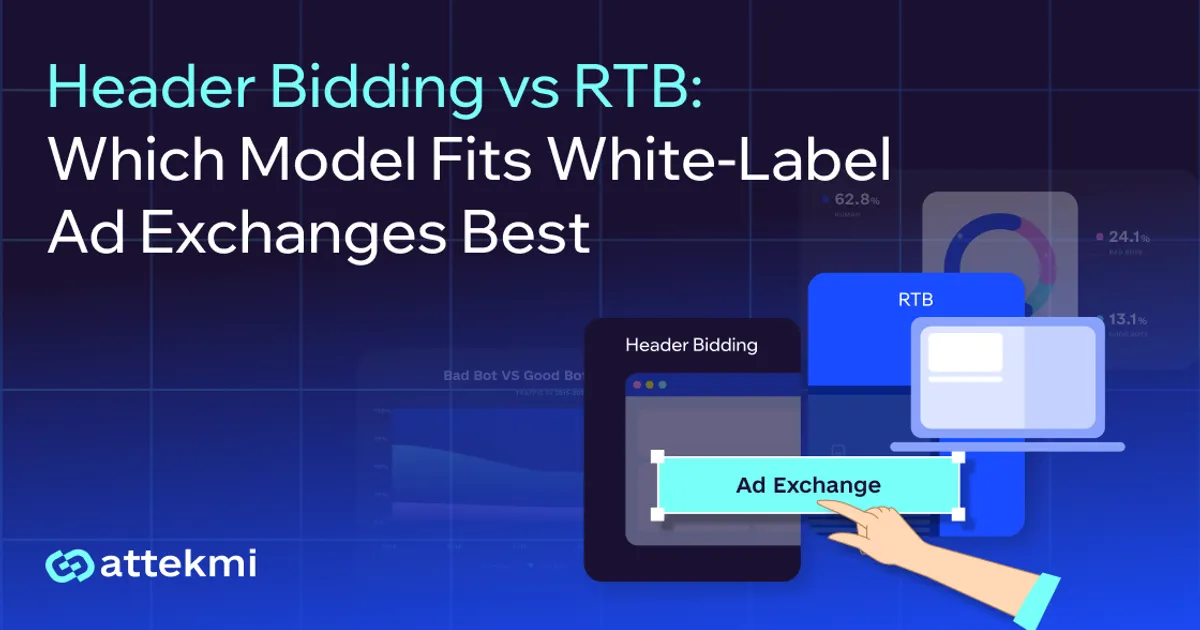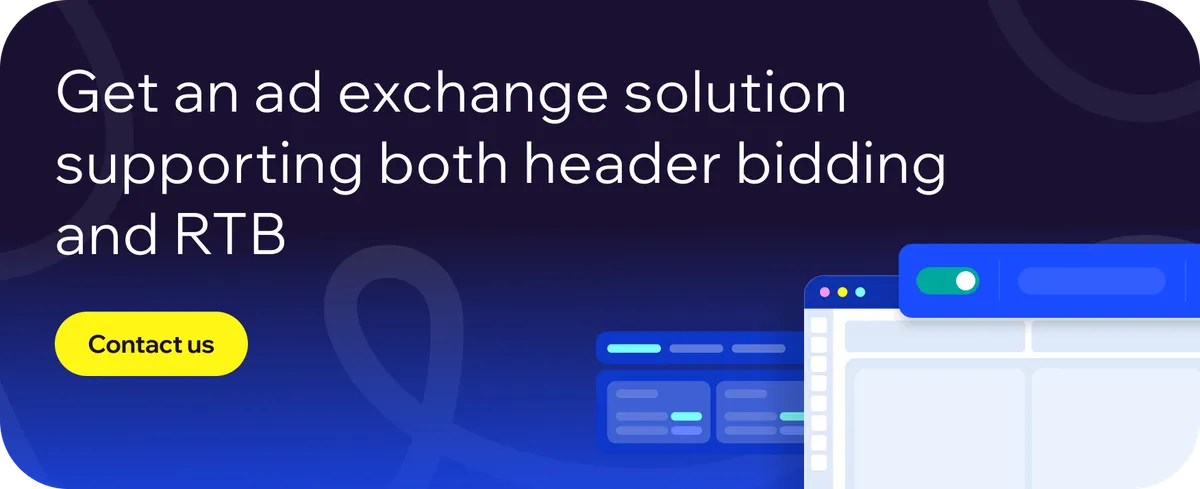In the programmatic buying ecosystem, the header bidding and RTB (real-time bidding) terms are often confused with one another. However, even though RTB and header bidding share some similarities, such as automating the media buying process, they are not the same. This is similar to the way businesses choose between white label vs private label solutions.
So, what is header bidding and why is it different to RTB? Operating in the programmatic industry since 2018, our Attekmi team knows everything about RTB and header bidding models, so we have prepared this guide to help you understand all the nuances. Read on and discover which approach is the best fit for your business.
Key Takeaways:
Header bidding is an evolution of RTB. It works within the programmatic ecosystem and brings higher transparency and revenue.
RTB remains the core auction model, but in white-label ad exchanges, it is often limited by waterfall logic.
Header bidding can boost CPM thanks to fair competition among advertisers.
Header bidding risks include potential page latency and higher technical complexity.
For white-label ad exchanges, header bidding is the best fit, combining transparency, control, and flexible partner integrations.
What is header bidding?
Enabled through the JavaScript library, the header bidding technology interacts with multiple demand-side platforms and ad exchanges concurrently, creating a unified auction for advertisers. Thus, instead of waiting for their turn (like it happens in the waterfall vs bidding model), all marketers get equal opportunities to access high-quality inventory (and any other inventory as well), which ensures fairer conditions for them. In turn, publishers benefit from increased demand and higher fill rates and drive income more effectively.
What is RTB?
RTB meaning plays an important role in today’s digital advertising landscape. Real-time bidding is a form of programmatic buying and, basically, it has become the basis for the emergence of header bidding technology. It usually works like this: an impression opportunity arises, and advertisers start competing for the inventory via a real-time auction. If that’s the first-price auction, the highest bid wins, and the amount placed is paid. In the case of the second price auction, the highest bid still gets the inventory, but the winner pays 1 cent more than the second-highest bid.
RTB seems effective, but it lacks transparency and equality since marketers bid one by one. Therefore, it may be challenging for some of them to access top ad space.
Header bidding vs RTB: 7 key differences
So, header bidding versus RTB. Which is better? To help you make a decision, we have prepared a sufficient header bidding vs RTB comparison outlining the key differences between the models.
Header Bidding vs Real-Time Bidding | ||
Header Bidding | RTB | |
What is it? | Header bidding is a subset of real-time bidding. | RTB is a subset of programmatic buying. |
How does the auction take place? | The auction is unified, with numerous DSPs and exchanges competing for an impression at the same time. | The auction is successive, with every platform performing it one at a time. |
How are the bids placed? | All the auction participants place bids simultaneously, which ensures equal and fair conditions for advertisers, as well as better transparency. | In the RTB waterfall model, the impression is first offered to the top-tier auction participants, then to the next tier, etc. |
What income do publishers get? | Publishers get higher revenue since they can sell their inventory at its real value and benefit from increased competition. | Trying to monetize the ad space, publishers often get lower income, especially during the second-price auctions. |
What inventory can advertisers buy? | Advertisers can access ad inventory of any quality, including premium ad space. Additionally, it is easier for them to reach niche audiences. | Marketers can purchase only the inventory that reaches their tier. |
Can there be latency? | Reduced latency due to simultaneous bidding. | Increased latency since the bidding process is sequential. |
Is there a chance for manipulation? | Header bidding utilizes open-source infrastructure (like Prebid.js), which helps to prevent manipulation. | RTB auctions may be prone to manipulation as the participants are not aware of each other’s bids. |
Let’s summarize the differences:
Both RTB and header bidding imply programmatic media buying. However, header bidding works as an enhanced version of RTB. The auctions still happen in real time, but in a slightly different way.
Header bidding auctions are unified, so all advertisers bid simultaneously. This way, everyone is on equal footing. In RTB successive auctions, you may not even get a chance to bid on the desired inventory.
With RTB, you can bid only on the inventory that reaches your tier. Header bidding solves this problem – you can compete for any ad space.
With header bidding, competition for the ad space increases, which means higher income for media owners. In the case of RTB, publishers’ revenue is often lower.
As for latency, it is a challenge related to both header bidding and RTB. However, in the case of header bidding, latency can be decreased by implementing server-side bidding. So, in general, it can be considered a less significant risk than for RTB.
The header bidding model is also less prone to manipulation.
So, real-time bidding vs header bidding. Who is the winner? Considering the comparison described above, the header bidding approach may seem to be more beneficial for both publishers and advertisers. It ensures transparency and creates equal conditions for all the bidders participating in the auction while also helping publishers drive revenue. Therefore, choosing a white-label ad exchange solution supporting header bidding may seem an obvious step.
However, you should remember that an effective marketplace implies flexibility. Instead of searching for a solution that offers exclusively header bidding, consider preferring one that supports different auction models.
RTB seems to be less effective for both parties involved, but it can still be useful for selling the remaining ad inventory. Besides, RTB is not only about first- and second-price auctions. Private marketplaces (PMPs) also fall under this term — only limited groups of marketers take part in such auctions, and publishers tend to use them to monetize their top ad inventory.
This way, some website and app owners can still benefit from the RTB approach, so you should offer multiple programmatic buying models to your demand and supply partners. Thanks to this, you will have more opportunities to monetize your ad exchange. Additionally, it would be wise to prefer a solution that is regularly updated. The programmatic industry is still evolving, so new buying models may enter the stage, and it is essential for you to be sure that your platform will start supporting them and remain competitive.
Build your own ad exchange brand with our expertise
So far, in the “battle” of real-time bidding vs header bidding, the latter model is the winner since it solved the inefficiencies of RTB. However, having both of them on your ad exchange is still a way to attract more partners and ensure stable media trading income. But how to integrate these models into your solution?
Creating an ad exchange from scratch and keeping it competitive is a challenging and time-consuming process. Therefore, instead of investing loads of resources into development, you may prefer another approach — for instance, choosing one of the Attekmi programmatic solutions.
Both header bidding and OpenRTB 2.6 are on the list of supported integrations. Besides, there are also some pretty unique options like VAST to RTB, which enables cross-integration and additional income opportunities for you.
Additionally, there are many more benefits like fraud detection scanners that you can integrate for your supply and demand partners, multiple traffic types and ad formats available, various targeting types for matching supply and demand side effectively, and so on.
Choosing Attekmi is a way to enter the programmatic industry promptly, achieve payback quickly, and start driving income. For instance, StreamKey achieved payback within 2 months and doubled its revenue after deploying our solution.
Build or buy? 5-step white-label ad exchange checklist
Now that the differences between RTB versus header bidding are clarified, let’s answer a new question. Should you build your ad exchange platform from scratch or go for a white-label solution? Here is a short checklist for you to make a decision.
Step 1: define your time-to-market goals
AdTech solutions are pretty complex, and ad exchanges are no exception. Building such a platform from the ground up may take years, while with a white-label solution, you can launch your marketplace within several weeks or even faster (this depends on the required level of customization).
Therefore, the first step you need to take is to define your time-to-market goals. When do you need your platform to enter the market? Will you fall behind competitors or miss some revenue opportunities in case you decide to build a platform on your own? Will there still be demand for that platform when it is finally ready?
Large businesses often prefer creating their own solutions since they have sufficient resources for doing this, and usually have something else to offer to their customers. They can still keep pace with their competitors while building an ad exchange platform from scratch. For instance, this year, Spotify launched an ad exchange – for such a large company, building a platform from the ground up is the best way to go. Besides, offering digital ad inventory to advertisers is not Spotify’s only activity – music listeners did not stop using the service while the company was working on an ad exchange solution.
However, smaller companies, especially startups, usually need the product to be launched in the shortest time possible, and this is when a white-label solution comes to the rescue.
Everything depends on your goals (and not only), but a white-label ad exchange enables you to start earning on media trading in the shortest time possible. Even if you want a provider to create several custom features for you, the product will still be launched much faster than if you were to build it completely from scratch.
Attekmi’s White Label Ad Exchange is fully customizable, from UI personalization to custom on-request feature development.
Step 2: analyze the costs and resources
Development from scratch is not only time-consuming – it requires loads of financial investments. So, define the features that you would like your ad exchange platform to have. Will it have only basic functionalities or some additional features (for instance, private marketplaces or direct deals) as well? Remember, to provide your partners with some flexibility, it would be wise to equip it with both RTB and header bidding capabilities. Then, estimate the full cost of in-house development: engineering, designing, testing, etc. Can your business afford such expenses? Will you be able to handle the sudden increase in expenses in case, for instance, the development process takes more time than you expected?
Besides, what about ongoing costs? You will still need to maintain your solution, as well as regularly upgrade it with new functionalities to ensure its competitiveness and effectiveness. Such costs can be harder to estimate, but you should still consider them.
In comparison with development from scratch, the white-label approach is much more cost-effective. First of all, it requires lower upfront investment. Secondly, operating expenses are lower as well, and they are easier to predict, which is especially important for businesses with tight budgets. Thirdly, the probability of bugs and errors is minimized. The solution is already time-tested, so the risks are much lower.
With Attekmi’s White Label Ad Exchange, you minimize not only time-to-market but also investments.
Step 3: pay attention to the technology aspect
Again, ad exchange solutions are complex – to be effective and profitable, they need much more than RTB and header bidding capabilities: advanced targeting and filtering settings, fraud detection and prevention functionalities, support for multiple ad formats and environments, analytics and reporting, and so on. Moreover, a solution must be compliant with all the relevant regulations like GDPR, COPPA, CCPA, and others. If it is not, you may face legal issues, while it will also be challenging for you to build trust.
So, does your team have the expertise required to build such a platform? Or will you need to entrust a third party with your project or hire more professionals to work on the development process?
Apart from this, keep in mind that the solution must be regularly updated with new functionalities. For instance, currently, connected TV (CTV) advertising is on the rise. Therefore, if you had your own ad exchange platform by this moment, you would need to integrate such capacities into it.
With a white-label solution, you do not have to worry about this. First of all, some providers (like Attekmi) offer customizable platforms, and customization opportunities go beyond branding. You can request additional features to be developed, so that your ad exchange solution will meet your needs in full. Besides, the provider is usually responsible for the platform maintenance and upgrades, so you will not have to do this on your own. Coming back to RTB and header bidding, most modern white-label platforms (the one from Attekmi is on the list) support both options, so you do not have to choose between them. You will be able to provide your supply and demand partners with different integration options, which will help you drive media trading income effectively.
The choice highly depends on your resources and technology capabilities, but with a white-label option, you enter the market in an accelerated and cost-effective manner.
Attekmi’s White Label Ad Exchange is ready to meet all your technological requirements.
Step 4: define your scalability capabilities
At some point, you will most likely need to scale your ad exchange platform so that it will be able to handle a greater number of ad requests without issues. Therefore, the next question to answer is whether your team is able to do this. Do you have enough resources to ensure the required scalability? Can you guarantee the essential speed and security?
White-label solutions are designed to withstand increasing workloads, and the provider team will help you scale effectively. Therefore, you will not have to deal with platform upscaling on your own – everything will happen smoothly.
Our White Label Ad Exchange is ready to grow together with your business.
Step 5: decide on your key business goals
Last but not least, review your core business goals and tasks. Is building an ad exchange platform from scratch your number one priority, or do you want to focus, for instance, on enhancing your strategy, building partnerships, or growing revenue? Will the development process distract you and your team from your main tasks?
With a white-label solution, you can keep prioritizing your key operations. The platform will enter the market promptly, and there will be no need for you to maintain or upgrade it. Besides, certain providers (and Attekmi is one of them) offer Ad Ops outstaffing services, so that you can count on an expert trained specifically for your business. Your operations will run smoothly, while you will be able to focus on your main business objectives.
Discover the heights your business can reach with Attekmi’s White Label Ad Exchange and AdTech and Ad Ops services.
Conclusions
Even though RTB revolutionized the advertising industry at the time, it is still not perfect. Header bidding emerged as a solution to its challenges, so we can consider it an obvious winner. However, this does not mean that ad exchange owners should integrate only header bidding capabilities into their platforms. RTB can still be helpful in certain cases, and it is also important to provide demand and supply partners with some flexibility. In general, the more options you offer, the better, but header bidding must definitely be on the list.
Keep in mind that getting a white-label ad exchange is a much faster way to enter the programmatic environment than building such a platform on your own. Prefer the solution that supports multiple programmatic buying models, including header bidding.
Does Attekmi look like a reliable partner to you? Then let’s get in touch!
FAQ
The main difference between header bidding and RTB is that header bidding auctions are unified, with multiple platforms competing for an impression at once. This creates more equal conditions for marketers. In turn, RTB auctions are successive, with a single platform performing at a time. Impressions are first offered to top-tier marketers, then to the second-tier, etc.
Header bidding enables better transparency and solves the challenges of RTB. It is more beneficial for both advertisers and publishers. However, owners of ad exchanges should still have both header bidding and RTB on their platforms to provide their partners with more opportunities.
Sure. Contact us, and we will help you choose the ad exchange platform that will meet all your needs.
 By Anastasiia Lushyna
By Anastasiia Lushyna
